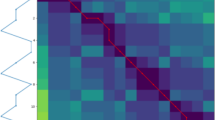Abstract
In this study, we propose a new dynamic warping algorithm for cyclic sequence comparison, which approximate the optimal solution efficiently. The comparison of two sequences, whose starting points are known, is performed by finding the optimal correspondence between their elements, which minimize the distance. If the sequences are cyclic and their starting points are not known, the alignment computation must determine the amount of cyclic shift for the optimal solution. However, this process increases the complexity of the algorithm and may be cumbersome especially for large databases. Instead of finding the optimal solution, the proposed algorithm finds the approximate distance at once and decreases the time complexity substantially. The algorithm is tested in boundary based shape similarity problem. The experiments performed on MPEG-7 Shape database, show that the proposed method performs better than the classical cyclic string comparison methods in the literature and gives very similar results with the optimal solution.
Preview
Unable to display preview. Download preview PDF.
Similar content being viewed by others
References
Arica, N., Yarman-Vural, F.T.: BAS: A Perceptual Shape Descriptor Based On The Beam Angle Statistics. Pattern Recognition Letters 24/9-10, 1627–1639 (2003)
Sankoff, D., Kruskal, J.: Time Warps, String Edits and Macromolecules. CLSI Publications (1999)
Maes, M.: On A Cyclic String-To-String Correction Problem. Information Processing Letters 35(2), 73–78 (1990)
Gregor, J., Thomason, M.G.: Efficient Dynamic Programming Alignment Of Cyclic Strings By Shift Elimination. Pattern Recognition 29(7), 1179–1185 (1996)
Gregor, J., Thomason, M.G.: Dynamic Programming Alignment Of Sequences Representing Cyclic Patterns. IEEE Trans. Pattern Analysis and Machine Intelligence 15(2), 129–135 (1993)
Bunke, H., Buhler, U.: Applications Of Approximate String Matching To 2-D Shape Recognition. Pattern Recognition 26(12), 1797–1812 (1993)
Mollineda, R.A., Vidal, E., Casacuberta, F.: Cyclic Sequence Alignments: Approximate Versus Optimal Techniques. International Journal Of Pattern Recognition and Artificial Intelligence 16(3), 291–299 (2002)
Gorman, J.W., Mitchell, O.R., Kuhl, F.: Partial Shape Recognition Using Dynamic Pro-gramming. IEEE Trans. Pattern Analysis and Machine Intelligence 10(2), 257–266 (1988)
Tell, D., Carlsson, S.: Combining appearance and topology for wide baseline matching. In: Heyden, A., Sparr, G., Nielsen, M., Johansen, P. (eds.) ECCV 2002. LNCS, vol. 2350, pp. 68–81. Springer, Heidelberg (2002)
Author information
Authors and Affiliations
Editor information
Editors and Affiliations
Rights and permissions
Copyright information
© 2005 Springer-Verlag Berlin Heidelberg
About this paper
Cite this paper
Arica, N. (2005). Cyclic Sequence Comparison Using Dynamic Warping. In: Leow, WK., Lew, M.S., Chua, TS., Ma, WY., Chaisorn, L., Bakker, E.M. (eds) Image and Video Retrieval. CIVR 2005. Lecture Notes in Computer Science, vol 3568. Springer, Berlin, Heidelberg. https://doi.org/10.1007/11526346_36
Download citation
DOI: https://doi.org/10.1007/11526346_36
Publisher Name: Springer, Berlin, Heidelberg
Print ISBN: 978-3-540-27858-0
Online ISBN: 978-3-540-31678-7
eBook Packages: Computer ScienceComputer Science (R0)




